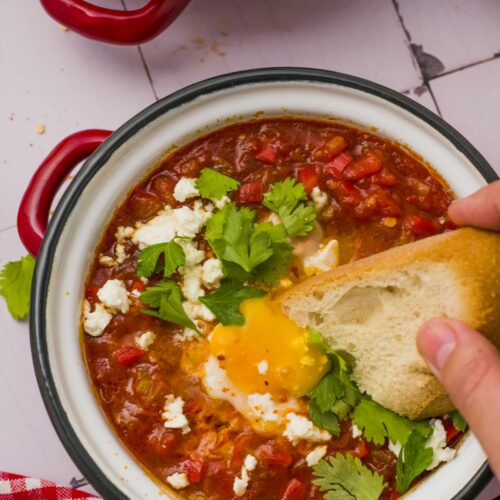Most people don’t eat instant food because they love it, but because it’s easy and cheap.
If you have 15 minutes in between Zoom calls and your stomach is growling, that microwave mac and cheese seems like it’s perfect. It’s not glamorous by any means, but it gets the job done.
People throw a lot of hate on anything instant because it’s all considered ‘unhealthy’. And, yes, it’s not ideal, but who says that you need to accept it exactly the way it is? Something small and salty can become an actual meal without cooking from scratch: no fancy ingredients, no chef skills, just a little bit of time.

And believe it or not, you already have all you need to make this happen because a handful of frozen veggies and a spoonful of real broth go a long way.
So before you write off instant food as a habit you need to shake, let’s see how to turn it into something better.
Why Instant Food Is Usually Unhealthy
You’ll find instant foods in pretty much any kitchen. Cup noodles, instant soups, frozen dinners, microwaveable rice bowls, these are all go-tos when you’re tired or short on time.
This is why they’re so popular with students and busy adults who juggle work and life. The problem with these meals is that they’re not very nutritious. They were built to sit on a shelf and be mass-produced cheaply, which makes them convenient but not very healthy.
They often have way too much sodium and barely any protein or fiber. As far as flavoring goes, it’s all artificial junk that tries to make up for the nonexistent fresh ingredients. And don’t even get me started on the preservatives. These are the reasons why you feel hungry and bloated an hour after you’ve had a cup of noodles.
And although health is the main concern, the packaging can be problematic, too. Some instant soup cups have such flimsy packaging that they’re a safety issue and can cause serious burns.
If that ever happens to you, you can contact Rosenfeld Injury Lawyers for a soup burn lawsuit, or you can consult a different law firm – just make sure they have experience in dealing with these types of cases, so that you maximize your chances of winning your case.
Ideally, you don’t want a burn to happen in the first place, but you never know, and it’s good to be prepared.
How to Transform Popular Instant Foods at Home (and Still Keep Them Convenient)
If you treat instant food as a base instead of a full meal, you can actually make it healthier. The problem with instant food is that it’s missing real flavor and nutrients, so if you can find a way to add them in, you can completely transform it.
Here’s how you do that.
Ramen Cups
Those little seasoning packets are the main reason your ramen feels like seawater, so instead of using the whole thing, swap it. Use a spoonful of low-sodium broth or miso paste, and you’ll get a deeper flavor.
You’ll also end up less dehydrated.
Once the noodles are done, throw in spinach, mushrooms, sliced scallions, or even leftover tofu.
You want something fresh, that’s the idea. I’d even ditch the friend noodles that come in the cup and use quick-cook, gluten-free noodles instead. It’s still fast and easy, but with more fiber and a lot less grease.
Instant Oatmeal Packets
Flavored oatmeal packets are usually nothing more than sugar and a tiny bit of oats.
Instead of this mess, start with plain quick oats and build the flavor yourself. Throw in a banana and drizzle it with honey, then top it off with chia or nuts for protein and texture.
If you want something smoother and creamier, add a splash of almond milk. It will make it more filling, and it will feel more like a real breakfast instead of a snack.
Instant Soup Cups or Packets
If you’ve ever had instant soup, you were probably shocked to see how watery and weak it is, so let’s change that.
Don’t use the full powder mix and instead, start with low-sodium broth. For flavor, add garlic or dried herbs. Toss in rinsed canned beans, frozen veggies, or leftover chicken, and you have an actual meal.
Oh, and please (!) don’t microwave or eat straight from the cup if the thing is made of thin plastic.
Microwaveable Mac and Cheese
The problem here isn’t the speed but the powdered cheese.
Let me tell you, that stuff is nasty with a big N. Throw that stuff out and get a handful of shredded cheddar or even nutritional yeast if you want something dairy-free (and I always recommend that) that still has real flavor.
While it’s still hot, mix in steamed broccoli or peas right in the bowl, and that’s it! You get fiber and nutrients, but it takes less effort than boiling and draining. If you’re buying mac cups often, I’d suggest looking for chickpea-based pasta versions for more protein.
Conclusion
I’m not telling you to ditch your microwave or to spend your weekends preparing meals for the entire week. But you need to stop treating instant food like they’re actual, finished meals because they’re not. They’re more like blank canvases in a sad little cup. At best, they’re a shortcut.
But if you add real ingredients to them, they stay convenient, but they also become nutritious. My point is, you don’t need more time, just better habits.
Quick meals are the GOAT; add some frozen peas to make them into real food.







